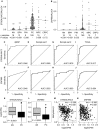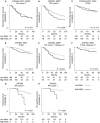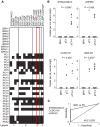Biomarker potential of ST6GALNAC3 and ZNF660 promoter hypermethylation in prostate cancer tissue and liquid biopsies
- PMID: 29465788
- PMCID: PMC5891052
- DOI: 10.1002/1878-0261.12183
Biomarker potential of ST6GALNAC3 and ZNF660 promoter hypermethylation in prostate cancer tissue and liquid biopsies
Abstract
Current diagnostic and prognostic tools for prostate cancer (PC) are suboptimal, leading to overdiagnosis and overtreatment. Aberrant promoter hypermethylation of specific genes has been suggested as novel candidate biomarkers for PC that may improve diagnosis and prognosis. We here analyzed ST6GALNAC3 and ZNF660 promoter methylation in prostate tissues, and ST6GALNAC3, ZNF660, CCDC181, and HAPLN3 promoter methylation in liquid biopsies. First, using four independent patient sample sets, including a total of 110 nonmalignant (NM) and 705 PC tissue samples, analyzed by methylation-specific qPCR or methylation array, we found that hypermethylation of ST6GALNAC3 and ZNF660 was highly cancer-specific with areas under the curve (AUC) of receiver operating characteristic (ROC) curve analysis of 0.917-0.995 and 0.846-0.903, respectively. Furthermore, ZNF660 hypermethylation was significantly associated with biochemical recurrence in two radical prostatectomy (RP) cohorts of 158 and 392 patients and remained significant also in the subsets of patients with Gleason score ≤7 (univariate Cox regression and log-rank tests, P < 0.05), suggesting that ZNF660 methylation analysis can potentially help to stratify low-/intermediate-grade PCs into indolent vs. more aggressive subtypes. Notably, ZNF660 hypermethylation was also significantly associated with poor overall and PC-specific survival in the RP cohort (n = 158) with long clinical follow-up available. Moreover, as proof of principle, we successfully detected highly PC-specific hypermethylated circulating tumor DNA (ctDNA) for ST6GALNAC3, ZNF660, HAPLN3, and CCDC181 in liquid biopsies (serum) from 27 patients with PC vs. 10 patients with BPH, using droplet digital methylation-specific PCR analysis. Finally, we generated a three-gene (ST6GALNAC3/CCDC181/HAPLN3) ctDNA hypermethylation model, which detected PC with 100% specificity and 67% sensitivity. In conclusion, we here for the first time demonstrate diagnostic biomarker potential of ST6GALNAC3 and ZNF660 methylation, as well as prognostic biomarker potential of ZNF660. Furthermore, we show that hypermethylation of four genes can be detected in ctDNA in liquid biopsies (serum) from patients with PC.
Keywords: ST6GALNAC3; ZNF660; biomarker; epigenetics; liquid biopsy; prostate cancer.
© 2018 The Authors. Published by FEBS Press and John Wiley & Sons Ltd.
Figures



Similar articles
-
Epigenetic silencing of MEIS2 in prostate cancer recurrence.Clin Epigenetics. 2019 Oct 22;11(1):147. doi: 10.1186/s13148-019-0742-x. Clin Epigenetics. 2019. PMID: 31640805 Free PMC article.
-
DNA methylation signatures for prediction of biochemical recurrence after radical prostatectomy of clinically localized prostate cancer.J Clin Oncol. 2013 Sep 10;31(26):3250-8. doi: 10.1200/JCO.2012.47.1847. Epub 2013 Aug 5. J Clin Oncol. 2013. PMID: 23918943
-
Comprehensive Evaluation of TFF3 Promoter Hypomethylation and Molecular Biomarker Potential for Prostate Cancer Diagnosis and Prognosis.Int J Mol Sci. 2017 Sep 20;18(9):2017. doi: 10.3390/ijms18092017. Int J Mol Sci. 2017. PMID: 28930171 Free PMC article.
-
Prognostic DNA methylation markers for prostate cancer.Int J Mol Sci. 2014 Sep 18;15(9):16544-76. doi: 10.3390/ijms150916544. Int J Mol Sci. 2014. PMID: 25238417 Free PMC article. Review.
-
DNA Methylation-Based Testing in Liquid Biopsies as Detection and Prognostic Biomarkers for the Four Major Cancer Types.Cells. 2020 Mar 5;9(3):624. doi: 10.3390/cells9030624. Cells. 2020. PMID: 32150897 Free PMC article. Review.
Cited by
-
Liquid biopsy for monitoring of tumor dormancy and early detection of disease recurrence in solid tumors.Cancer Metastasis Rev. 2023 Mar;42(1):161-182. doi: 10.1007/s10555-022-10075-x. Epub 2023 Jan 6. Cancer Metastasis Rev. 2023. PMID: 36607507 Free PMC article. Review.
-
Sialyltransferases and Neuraminidases: Potential Targets for Cancer Treatment.Diseases. 2022 Nov 28;10(4):114. doi: 10.3390/diseases10040114. Diseases. 2022. PMID: 36547200 Free PMC article. Review.
-
Screening and identification of Theileria annulata subtelomere-encoded variable secreted protein-950454 (SVSP454) interacting proteins from bovine B cells.Parasit Vectors. 2021 Jun 11;14(1):319. doi: 10.1186/s13071-021-04820-4. Parasit Vectors. 2021. PMID: 34116718 Free PMC article.
-
Epigenetic silencing of MEIS2 in prostate cancer recurrence.Clin Epigenetics. 2019 Oct 22;11(1):147. doi: 10.1186/s13148-019-0742-x. Clin Epigenetics. 2019. PMID: 31640805 Free PMC article.
-
Identification of key DNA methylation-driven genes in prostate adenocarcinoma: an integrative analysis of TCGA methylation data.J Transl Med. 2019 Sep 18;17(1):311. doi: 10.1186/s12967-019-2065-2. J Transl Med. 2019. PMID: 31533842 Free PMC article.
References
-
- Bakardzhiev IV, Dechev ID, Wenig T, Mateva NG and Mladenova MM (2012) Repeat transrectal prostate biopsies in diagnosing prostate cancer. Folia Med (Plovdiv) 54, 22–26. - PubMed
-
- Bastian PJ, Palapattu GS, Lin X, Yegnasubramanian S, Mangold LA, Trock B, Eisenberger MA, Partin AW and Nelson WG (2005) Preoperative serum DNA GSTP1 CpG island hypermethylation and the risk of early prostate‐specific antigen recurrence following radical prostatectomy. Clin Cancer Res 11, 4037–4043. - PubMed
-
- Baylin SB, Herman JG (2000) DNA hypermethylation in tumorigenesis, epigenetics joins genetics. Trends Genet 16, 168–174. - PubMed
Publication types
MeSH terms
Substances
LinkOut - more resources
Full Text Sources
Other Literature Sources
Medical
Molecular Biology Databases

